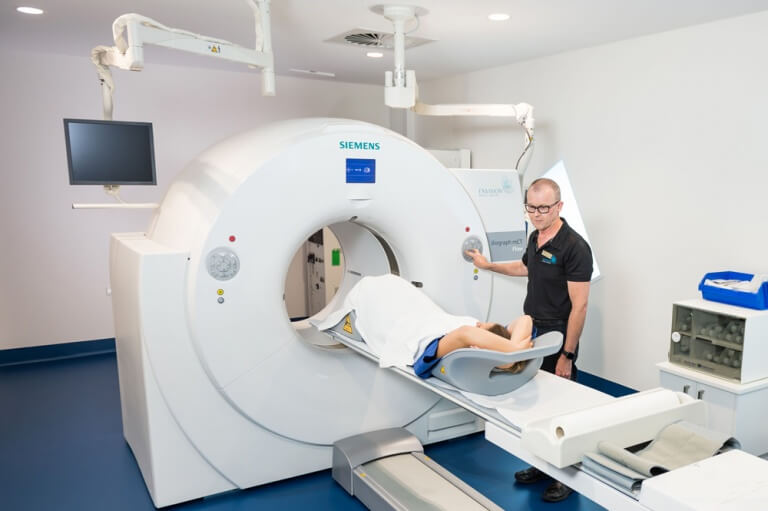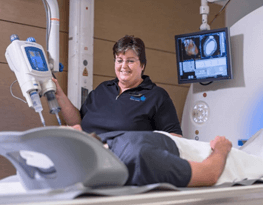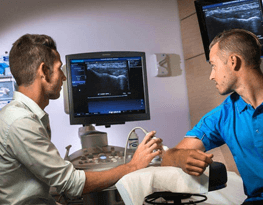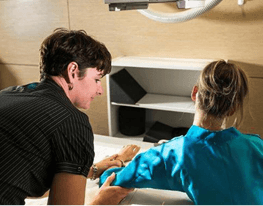What is an FDG PET-CT Scan – Cardiac Viability?

During an FDG PET-CT Scan for Cardiac Viability, radioactive glucose (FDG) is used to determine the viability of damaged heart muscle following a heart attack. This is important as these areas of heart muscle may be preserved by interventions such as stents or bypass grafts which divert blood supply to the affected area thereby restoring heart function.
FDG PET-CT Scan – Cardiac Viability
What happens during an FDG PET-CT Scan– Cardiac Viability?
A. Before your scan
What to bring
- Any relevant previous imaging
- Your Medicare card
To help us get an optimal FDG PET-CT scan Cardiac Viability it is important that you read the following instructions prior to your appointment.
Preparation – The day before the scan
- Avoid any strenuous exercise for at least 24 hours prior to your PET-CT scan
- If you have either Type 1 or Type 2 diabetes please contact Envision on 6382 3888 to discuss your preparation
- If you think you may be pregnant, please inform our Nuclear Medicine team before your examination commences
Preparation – On the day of the scan
YOU MUST FAST FOR AT LEAST 6 HOURS PRIOR TO YOUR PET-CT SCAN FOR CARDIAC VIABILITY.
The preparation for a Cardiac Viability FDG PET-CT scan test is different from that of a normal FDG PET-CT scan as blood sugar levels must be manipulated to promote the heart muscle to take up the radioactive glucose.
Remember during the fasting period to drink only water and be aware that fasting also includes avoiding the following substances:
- Flavoured water
- Chewing gum and cough lozenges
- Black tea and coffee
Drink at least 1 litre of water prior to your PET-CT appointment.
Medications
Take all medications except those for diabetes as normal. Use only water to take medications.
What to wear
Avoid wearing jewelry and wear warm comfortable clothing without metallic zippers, buttons or labels. If you don’t have access to clothing without metal zippers etc, a gown will be provided.
Appointment duration
A PET-CT scan for cardiac viability may take up to 4 hours from the time you arrive till completion. For the majority of that time you will be having measurements taken of your blood sugar level to determine the optimal time for the injection of the FDG. Once the FDG is injected you will be made comfortable in a special room for at least 45 minutes to allow time for the FDG to accumulate in the heart. The FDG PET/CT scan itself will only take about 20 minutes.
The preparation for this test is different from that of a normal FDG PET-CT scan as it is necessary to promote glucose metabolism by the heart prior to the injection of FDG.
B. During your FDG PET-CT Scan – Cardiac Viability
Upon arrival, you will be asked to fill in a questionnaire prior to being escorted to the PET-CT department. You will then have your weight and height measured before a brief interview with a nuclear medicine technologist. The technologist will then escort you to one of our uptake rooms. This room is a small area which contains a comfortable chair where the technologist will perform a test to measure your Blood Sugar Level (BSL) prior to the injection of radioactive glucose. Once your baseline BSL has been measured you will be asked to drink a glucose solution to deliberately increase you BSL. Your BSL will then be measured every hour and when the measurement indicates your BSL is decreasing you will be injected with the radioactive glucose. In this way, the radioactive glucose is “forced” into the heart muscle.
Don’t expect to feel anything from the injection, as the FDG causes no side effects. Once the injection has been given, you will be left to relax for 45 minutes prior to being taken through for your FDG PET-CT scan. During this “uptake” period it is important that you avoid any activities such as reading, texting or excessive movement as this may to lead abnormalities of tracer distribution in the body.
After the uptake period, you will be asked to empty your bladder prior to being escorted into the PET-CT scanner room and positioned on the scanner bed. An ECG signal is required to image the heart so you will have ECG electrodes attached to your chest prior to imaging. A low dose CT scan is acquired first. This involves two planning or scout x-rays which are acquired so that the technologist can accurately plan which area of the body will be covered by the PET-CT scan. The low dose CT is then acquired. This takes approximately one minute to complete and then the scanner bed will move into position for the PET part of the scan. The cardiac FDG PET-CT scan will take about 20 minutes to complete
Once the PET-CT scan is complete, you may also have a diagnostic CT but this depends on what your specialist has requested.
Once finished you are required to wait for about 15 minutes so that your images can be checked for diagnostic quality.
Risks and side effects
Nuclear medicine examinations including PET-CT are considered safe with almost no reported adverse reactions attributable to the radiopharmaceuticals used in these examinations.
PET-CT scans expose the patient to gamma radiation that is injected (the radioactive tracer) as well as x-rays which are generated by the CT scan component of the test. The level of radiation exposure from a PET-CT scan is minimal and Envision Medical Imaging has invested in the latest technology and employs professionals trained in radiation reduction techniques so that any radiation exposure is kept as low as possible.
It is not uncommon for a diagnostic CT scan to be performed at the same appointment as the PET-CT scan. Diagnostic CT is usually performed after the injection of a contrast agent which contains iodine. When a CT or an x-ray of the body is performed many areas appear as a similar shade of gray. Contrast agents are used to highlight blood flow, lymph nodes and organs.
There is a small risk of an allergic reaction from contrast agents and you will be asked to fill in a questionnaire to determine any potential risk prior to the test. In the unlikely event that you have a reaction to contrast Envision staff are trained in emergency procedures and have all the necessary equipment and medications to deal with any problems.
If you are worried or concerned about the test or the radiation exposure involved please speak with the nuclear medicine technologist when you go through for your appointment.
Who will perform my scan?
At Envision Medical Imaging, your PET-CT scan will be performed by a Nuclear Medicine Technologist, who has a degree in Medical Imaging, is accredited with the Australian Health Practitioner Regulation Agency (AHPRA) and holds a specialised license to practice Nuclear Medicine and CT from the Radiation Council of Western Australia.
FDG PET-CT Scan – Cardiac Viability
What happens after an FDG PET-CT Scan – Cardiac Viability?
How do I get my results?
Immediately after the PET-CT scan you may be asked to wait until your images are checked for diagnostic quality. If you have moved during the scan you may be asked to stay until an additional image of the affected body part can be taken.
If the scan is deemed to be of good quality you may then leave the department and resume your daily activities. There are no residual effects from the tracer or the PET-CT scan.
Your images will be reviewed along with your relevant medical history, and any other imaging, and be reported on by our Nuclear Medicine Radiologist or Nuclear Medicine Physician.
If your results are needed urgently, or you have an appointment straight after your scan with you referring doctor or health care provider, Envision Medical Imaging will arrange to have your results available immediately. Otherwise your referring doctor will receive your report within 48 hours of your examination. Please ensure that you make a follow up appointment with your referring doctor to discuss the results.
Post procedural information
After your scan you will be able to return to your normal daily activities.
FDG PET-CT Scan – Cardiac Viability
Download an Information and Consent Form
Medical Imaging Practice Perth
Types of Imaging
At Envision, we offer the most sought-after types of imaging for diagnostics and treatments. Our Wembley headquarters is the largest single-site radiology practice in Perth







